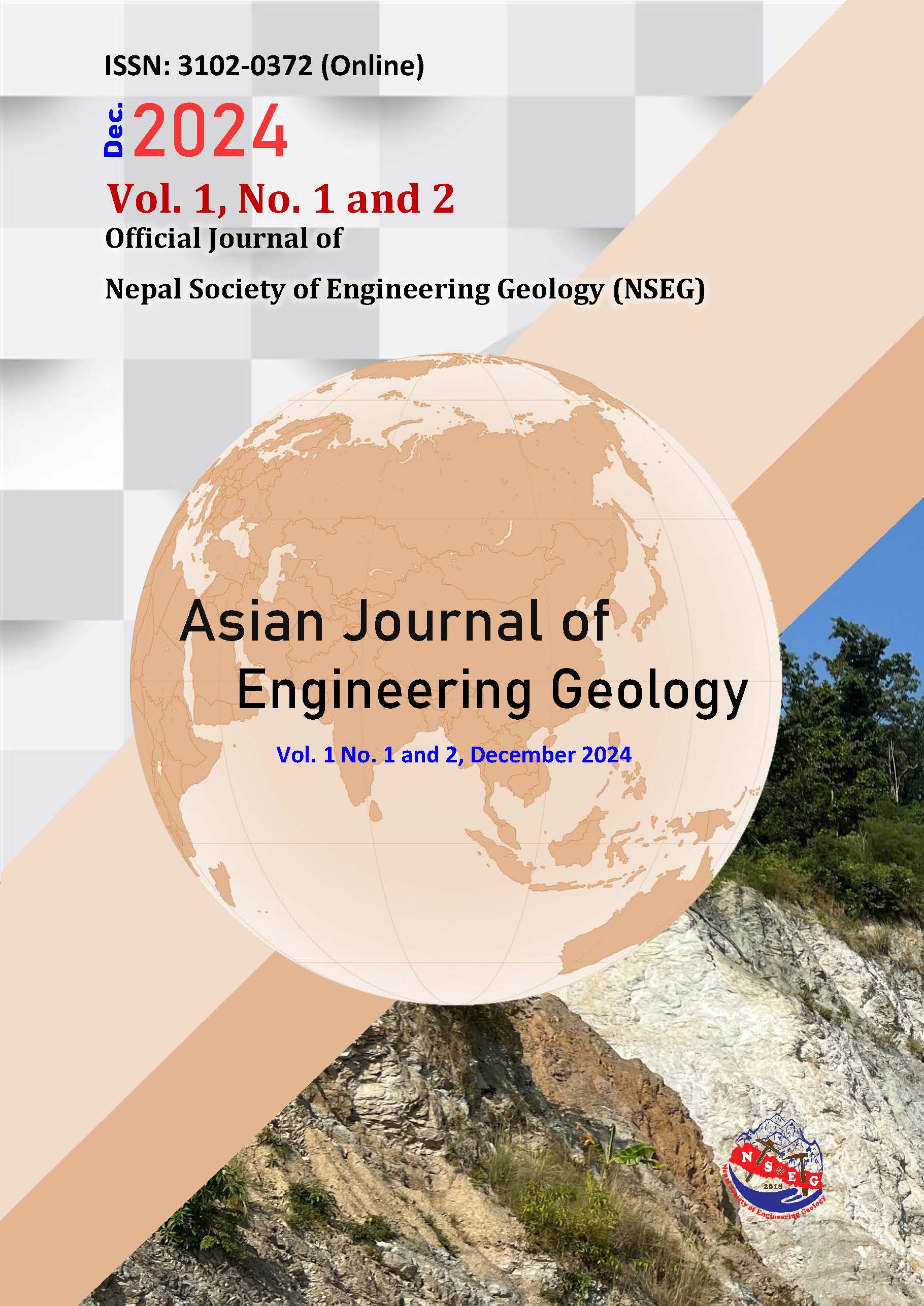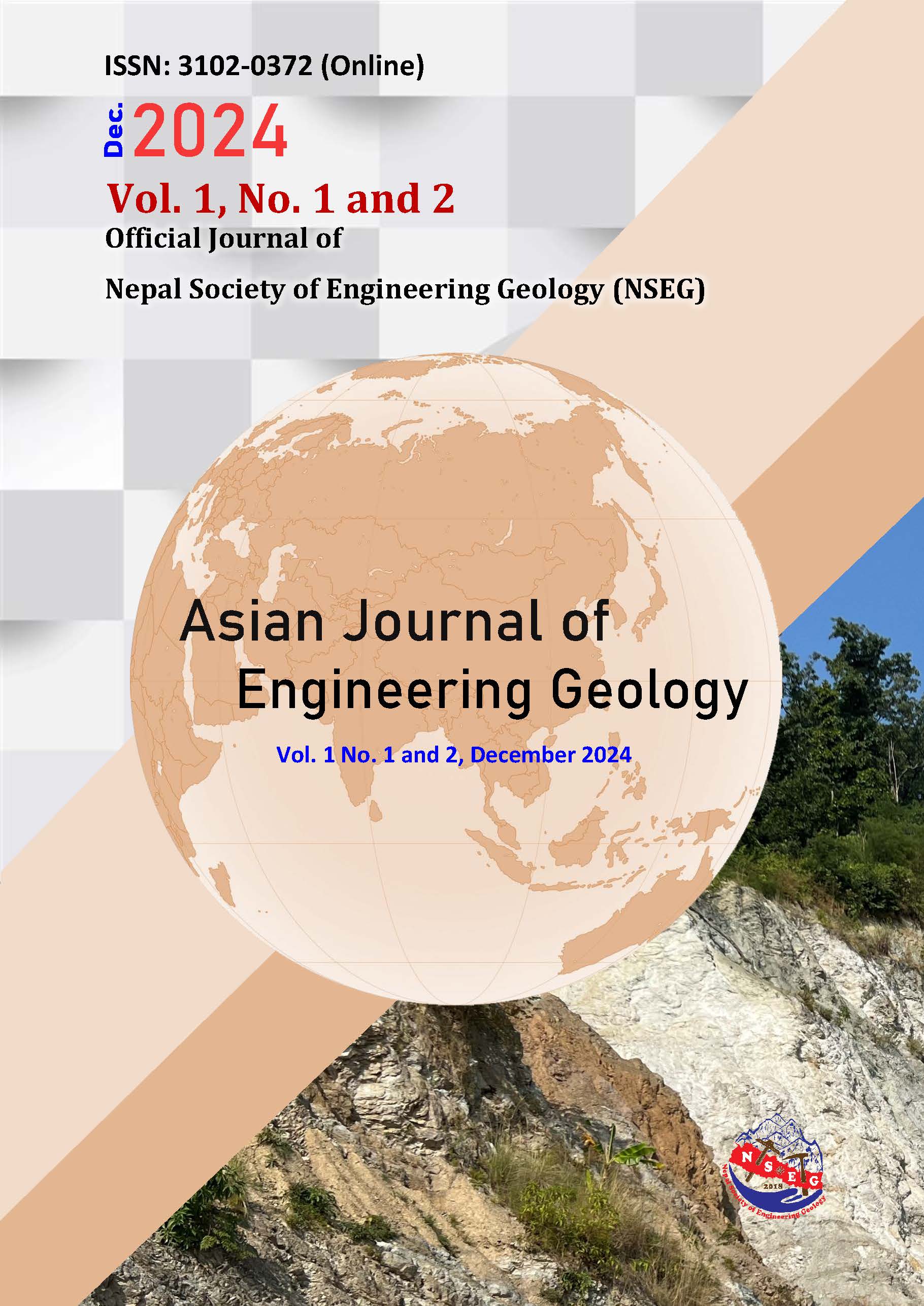Influence of Precipitation Variability on Pore Water Pressure and Surface Layer Failures in Naturally Undulating Slopes at Nau Kilo, Narayanghat–Mugling Road, Central Nepal
DOI:
https://doi.org/10.64862/ajeg.112.05Keywords:
Hillslope Hydrology, Threshold for Shallow Failures, Pore Warer PressureAbstract
This study investigates the role of pore water pressure variations in slope failures within naturally undulated hill slopes characterized by topographic hollows. A representative slope with a distinct hollow and six rainfall-induced failures recorded between 2001 and 2023 was selected for detailed analysis. Seepage and slope stability modeling were conducted in GeoStudio using the July 31, 2003, precipitation event, with simulations incorporating 24-hour maximum rainfall data corresponding to 5, 10, 25, 50, and 100-year return periods. These events were normalized using 6-minute interval rainfall data, and potential seepage face boundary conditions were applied. The results demonstrated a threshold relationship between hollow area and maximum pore water pressure, indicating that larger hollows generate higher pore water pressures under extreme rainfall. Specifically, a hollow of 100 m² was found to develop a maximum pore water pressure of 6.94 kPa. The findings highlight that topographic hollows act as hydrological convergence zones, increasing subsurface saturation and instability during intense rainfall events. The developed threshold relationship offers a predictive framework for assessing slope failure susceptibility in similar geomorphic settings, contributing to more effective hazard assessment and early warning systems.
References
Acharya K. P., Bhandary N. P., Dahal R. K. and Yatabe R. (2016). Seepage and slope stability modelling of rainfall-induced slope failures in topographic hollows. Geomatics, Natural Hazards and Risk, 7(2), 721-746. https://doi.org/10.1080/19475705.2014.954150
Acharya K. P., Yatabe R., Bhandary N. P. and Dahal R. K. (2016). Deterministic slope failure hazard assessment in a model catchment and its replication in neighbourhood terrain. Geomatics, Natural Hazards and Risk, 7(1), 156-185. http://dx.doi.org/10.1080/19475705.2014.880856
Beven K. J. and Kirkby M. J. (1979). A physically based, variable contributing area model of basin hydrology/Un modèle à base physique de zone d'appel variable de l'hydrologie du bassin versant. Hydrological sciences journal, 24(1), 43-69. https://doi.org/10.1080/02626667909491834
Bronstert A. (1994). Modellierung der Abflussbildung und der Bodenwasserdynamik von Hangen Dissertation, Karlsruhe, Karlsruher Institut für Technologie (KIT).
Campbell R. H. (1975). Soil slips, debris flows, and rainstorms in the Santa Monica Mountains and vicinity, southern California (Vol. 851). US Government Printing Office. https://doi.org/10.3133/pp851
Cardinali M., Galli, M., Guzzetti, F., Ardizzone, F., Reichenbach, P. and Bartoccini, P. (2006). Rainfall induced landslides in December 2004 in south-western Umbria, central Italy: types, extent, damage and risk assessment. Natural Hazards and Earth System Sciences, 6(2), 237-260. https://doi.org/10.5194/nhess-6-237-2006.
Carrivick J. L. (2007). Hydrodynamics and geomorphic work of jökulhlaups (glacial outburst floods) from Kverkfjöll volcano, Iceland. Hydrological Processes: An International Journal, 21(6), 725-740. http://dx.doi.org/10.1002/hyp.6248
Crosta G. (1998). Regionalization of rainfall thresholds: an aid to landslide hazard evaluation. Environmental Geology, 35(2-3), 131-145. https://doi.org/10.1007/s002540050300
Crozier M. J. (1999). Prediction of rainfall‐triggered landslides: A test of the antecedent water status model. Earth Surface Processes and Landforms, 24(9), 825-833. https://doi.org/10.1002/(SICI)1096-9837(199908)24:9<825::AID-ESP14>3.0.CO;2-M
Dahal R. K. and Hasegawa S. (2008). Representative rainfall thresholds for landslides in the Nepal Himalaya. Geomorphology, 100(3-4), 429-443. https://doi.org/10.1016/j.geomorph.2008.01.014
Dahal R. K., Hasegawa S., Nonomura A., Yamanaka M., Masuda T. and Nishino K. (2008). GIS-based weights-of-evidence modelling of rainfall-induced landslides in small catchments for landslide susceptibility mapping. Environmental Geology, 54, 311-324. http://dx.doi.org/10.1007/s00254-007-0818-3
Dahal R. K., Hasegawa S., Yamanaka M. and Bhandary, N. P. (2011). Rainfall-induced landslides in the residual soil of andesitic terrain, western Japan. Journal of Nepal Geological Society, 42, 137-152. https://doi.org/10.3126/jngs.v42i0.31461
Dahal R. K., Hasegawa S., Yamanaka M., Dhakal S., Bhandary N. P. and Yatabe R. (2009). Comparative analysis of contributing parameters for rainfall-triggered landslides in the Lesser Himalaya of Nepal. Environmental Geology, 58, 567-586. http://dx.doi.org/10.1007/s00254-008-1531-6
Dietrich W. (1987). Overview:" Zero-order basins" and problems of drainage density, sediment transport and hillslope morphology. International Association of Hydrological Sciences Publication, 165, 27-37.
Dietrich, W. and Dunne T. (1978). Sediment budget for a small catchment in a mountainous terrain. http://doi.org /10.1130/0091-7613(2001)029
Dietrich W. E., de Asua R. R., Coyle J., Orr, B. and Trso, M. (1998). A validation study of the shallow slope stability model, SHALSTAB, in forested lands of Northern California. Stillwater Ecosystem, Watershed and Riverine Sciences. Berkeley, CA.
Dunne T. (1978). Field studies of hillslope flow processes. In Hillslope Hydrology; Kirkby, M.J., Ed.; John Wiley & Sons: New York, NK, 227-293.
USA, 1978.
Frattini P., Crosta G. and Sosio R. (2009). Approaches for defining thresholds and return periods for rainfall‐triggered shallow landslides. Hydrological Processes: An International Journal, 23(10), 1444-1460. https://doi.org/10.1002/hyp.7269
Fredlund D. G. and Xing, A. (1994). Equations for the soil-water characteristic curve. Canadian geotechnical journal, 31(4), 521-532. https://doi.org/10.1139/t94-061
Guzzetti F., Cardinali M., Reichenbach P., Cipolla F., Sebastiani C., Galli M. and Salvati, P. (2004). Landslides triggered by the 23 November 2000 rainfall event in the Imperia Province, Western Liguria, Italy. Engineering Geology, 73(3-4), 229-245. https://doi.org/10.1016/j.enggeo.2004.01.006
Hilberts A. G. J. (2006). Low-dimensional modeling of hillslope sub-surface flow processes: developing and testing the hillslope-storage Boussinesq model. Wageningen University and Research. https://doi.org/10.1029/2006WR004964
Jacob A., Thomas A. A., Nath A. G. and MP, A. (2018). Slope stability analysis using Plaxis 2D. International Research Journal of Engineering and Technology (IRJET), 5(4), 3666-3668. Retrieved from https://www.irjet.net/archives/V5/i4/IRJET-V5I4820.pdf. Accessed on 23 Dec 2023.
Khan M. I. and Wang, S. (2021). Slope stability analysis to correlate shear strength with slope angle and shear stress by considering saturated and unsaturated seismic conditions. Applied Sciences, 11(10), 4568. http://dx.doi.org/10.3390/app11104568
Kvalstad T. J., Nadim F., Kaynia A. M., Mokkelbost K. H. and Bryn P. (2005). Soil conditions and slope stability in the Ormen Lange area. Marine and Petroleum Geology, 22(1-2), 299-310. http://dx.doi.org/10.1016/j.marpetgeo.2004.10.021
Lanni C. (2012). Hydrological controls on the triggering of shallow landslides: from local to landscape scale Doctoral thesis in Environmental Engineering, XXIV cycle Faculty of Engineering, University of Trento Academic year 2011/2012. Unpublished, 155p. Retrieved from https://iris.unitn.it/retrieve/b08d6fd7-94f5-44b5-b4da-036dbef3b013/LanniC_PhD_thesis.pdf. Accessed on 20 Dec 2023.
Marquez R. M. (2004). Three-dimensional slope stability analysis using finite elements. 2000-2009-Mines Theses and Dissertations, Unpublished, 101p. Retrieved from https://repository.mines.edu/server/api/core/bitstreams/17af1632-431d-47ef-b1f7-33d4b4c07875/content. Accessed on 16 Dec 2023.
Pack R. T., Tarboton, D. G., and Goodwin, C. (1999). SINMAP 2.0-A stability index approach to terrain stability hazard mapping, user's manual. 73p. Retrieved from https://digitalcommons.usu.edu/cee_facpub/16/. Accessed on 12 Nov 2023.
Paniconi C., Troch P. A., van Loon E. E. and Hilberts A. G. (2003). Hillslope‐storage Boussinesq model for subsurface flow and variable source areas along complex hillslopes: 2. Intercomparison with a three‐dimensional Richards equation model. Water resources research, 39(11). http://dx.doi.org/10.1029/2002WR001728
Pasuto A. and Silvano S. (1998). Rainfall as a trigger of shallow mass movements. A case study in the Dolomites, Italy. Environmental Geology, 35(2-3), 184-189.
Paudyal K. (2017). Geological and Petrological evolution of the Lesser Himalaya between Mugling and Damauli, central Nepal
Paudyal K., Adhikari L., Maharjan N. and Paudel L. (2012). Geological setting and lithostratigraphy of Bandipur-Gondrang area of Lesser Himalaya, central Nepal. Bulletin of the Department of Geology, 15, 49-62. https://doi.org/10.3126/bdg.v15i0.7417
Paudyal K. and Paudel, L. (2011). Geological setting and lithostratigraphy of the Lesser Himalaya in the Mugling-Banspani area, central Nepal. Journal of Nepal Geological Society, 42, 51-63. https://doi.org/10.3126/jngs.v42i0.31449
Pradhan S. (2014). Stability analysis of open PIT slope using FLAC, (M.Sc. Thesis), Department of Mining Engineering, National Institute of Technology, Rourkela-769008, India. Unpublished, 69p. Retrieved from https://core.ac.uk/download/pdf/53190326.pdf. Accessed on Dec 14 2023.
Rigon R., Bertoldi G. and Over T. M. (2006). GEOtop: A distributed hydrological model with coupled water and energy budgets. Journal of Hydrometeorology, 7(3), 371-388. https://doi.org/10.1175/JHM497.1
Sassa, K. (1998). Mechanisms of Landslide Triggered Debris Flows. In: Sassa K. (eds) Environmental Forest Science. Forestry Sciences, vol 54. Springer, Dordrecht. https://doi.org/10.1007/978-94-011-5324-9_53.
Setyawan A., Alina A., Suprapto D., Gernowo R., Suseno J. E. and Hadiyanto H. (2021). Analysis slope stability based on physical properties in Cepoko Village, Indonesia. Cogent Engineering, 8(1), 1940637. https://doi.org/10.1080/23311916.2021.1940637
Sidle R. (1987). A dynamic model of slope stability in zero order basin. IAHS publ., 165, 101-110.
Stöcklin J. (1980). Geology of Nepal and its regional frame: Thirty-third William Smith Lecture. Journal of the Geological Society, 137(1), 1-34. https://doi.org/10.1144/gsjgs.137.1.0001
Sun Y., Yang K., Hu R., Wang G. and Lv J. (2022). Model Test and Numerical Simulation of Slope Instability Process Induced by Rainfall. Water, 14(24), 3997. https://doi.org/10.3390/w14243997
Tsukamoto Y. and Minematsu, H. (1987). Hydrogeomorphological characteristics of a zero-order basin. IAHS-AISH publication (165), 61-70.
van Asch T. W., Buma J. and Van Beek L. (1999). A view on some hydrological triggering systems in landslides. Geomorphology, 30(1-2), 25-32. https://doi.org/10.1016/S0169-555X(99)00042-2
VanderKwaak J. E. (1999). Numerical simulation of flow and chemical transport in integrated surface-subsurface hydrologic systems. 243p. Retrieved from https://uwspace.uwaterloo.ca/bitstreams/6c08afbe-8097-4b6d-95a4-6ba62fb74642/download. Accessed on 17 Nov 2023.
Wagner A., Leite E. and Oliver R. (1990). A landslide hazard mapping software (version 1.0), 2 volumes. ITECO CH and University of Lausanne, Switzerland, 4.
Downloads
Published
Issue
Section
License
Copyright (c) 2024 Nepal Society of Engineering Geology (NSEG)

This work is licensed under a Creative Commons Attribution 4.0 International License.




